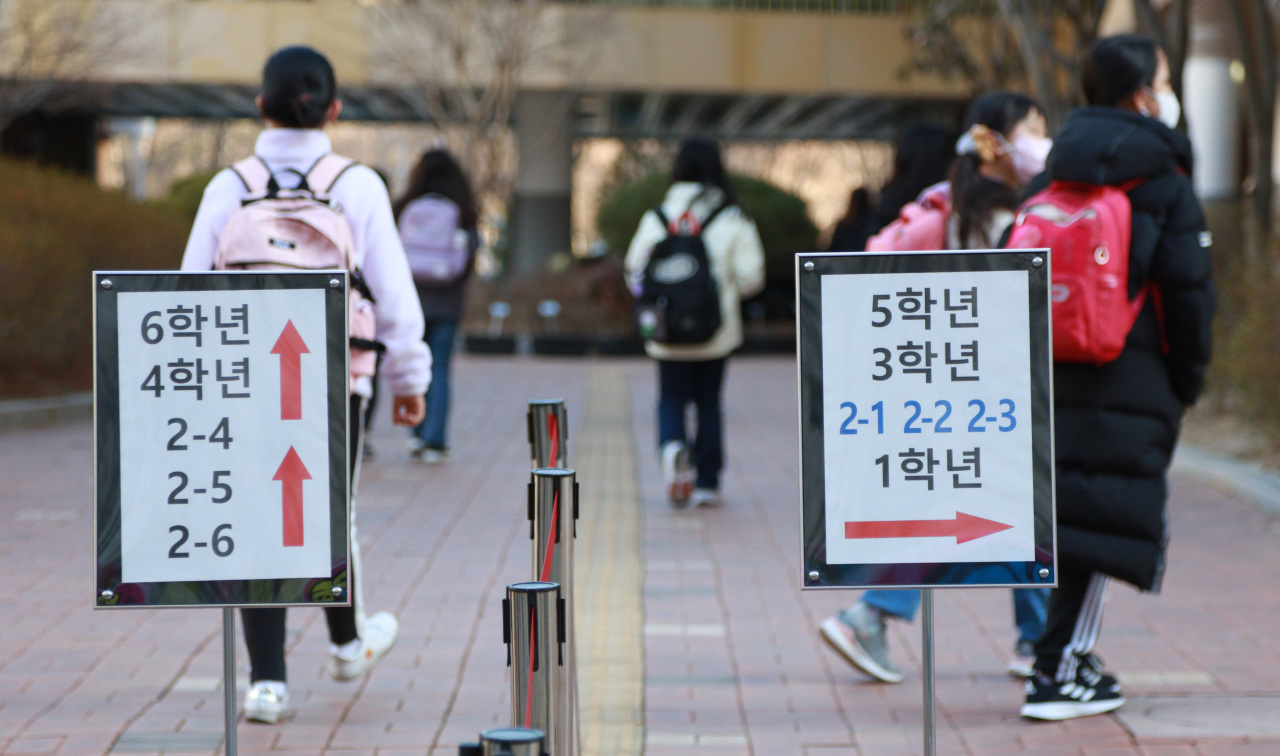
The new school year kicked off Wednesday while the country’s daily COVID-19 tally soared to nearly 220,000.
According to the Korea Disease Control and Prevention Agency’s report on Wednesday, the number of daily cases here reached 219,241, up 80,248 from the previous day.
The total caseload reached 3,492,686 accordingly, the country’s health authorities said.
Despite the tally, most schools opted for in-person classes Wednesday.
Though the Education Ministry gave schools the option of going completely online for the first two weeks of March, some education offices announced schools would open with face-to-face classes for the new semester.
Schools not given guidance by district education offices surveyed parents asking whether they want online classes or face-to-face classes for their children.
The ministry had previously announced schools could adjust their attendance policies if the number of newly confirmed daily cases surpasses 3 percent of total students, or if students in isolation related to COVID-19 exceeds 15 percent.
“Thanks to the efforts from children, parents and faculty members, students were able to attend classes,” Education Minister Yoo Eun-hye said at Jiphyeon Elementary School in Sejong, Wednesday.
“Over the past two years of responding to the COVID-19 situation, schools are experienced enough to safely run classes, backed by an infectious disease control and prevention system.”
“We are running an emergency response system that connects the Education Ministry with education offices and schools,” Yoo said. “Schools can run flexibly, responding effectively to the infectious disease.”
Seoul’s Education Superintendent Cho Hee-yeon also visited an elementary school in southern Seoul on Tuesday to welcome students.
“Though the omicron variant is at its peak, (face-to-face class) is a hurdle we must face,” Cho said. “Parents are preferring and welcoming the new attendance measure as there are numerous side effects related to the decrease of face-to-face classes.”
As the ministry has advised students to test themselves twice a week, schools gave out self-testing kits to students. Students are recommended to share their health information with schools by updating a self-diagnosis application on their mobile devices.
The attendance rule is set to change from the third week of March.
Until March 13, students living with a confirmed COVID-19 patient can attend school if they have been fully vaccinated. Those who have not been vaccinated will not be allowed to come to class for seven days.
From March 14, after the transition period ends, students who live with a confirmed COVID-19 patient can attend school regardless of their vaccination records. The ministry suggests students refrain from attending schools for three days, until they receive their PCR test results.
Meanwhile, Ministry of Health and Welfare spokesperson Son Young-rae noted the figure spiked as many people were tested amid the omicron wave during a radio interview on Wednesday. Son said the total number of COVID-19 tests reported for Tuesday surpassed 1 million.
The number of COVID-19 related deaths reached 96 during the 24 hours of Tuesday, slightly down from 112 the previous day. The death toll hit 8,266, as the fatality rate stood at 0.24 percent.
The number of critically ill COVID-19 patients, however, rose to 762 from 727 a day earlier.
Prime Minister Kim Boo-kyum, however, stressed that the country has sufficient medical capacity to handle the current number of critically ill patients and virus-related deaths during a COVID-19 response meeting on Wednesday.
“(South Korea) has secured 2,700 hospital beds and has bed occupancy rates of 50 percent, although the number of critically ill patients continues to increase,” Kim said.
Kim added the country is “keeping the COVID-19 fatality rate low, thanks to its high vaccination rate.” According to Kim, the fatality rate for people under 60 who had gotten their third shots is currently at zero percent.
Kim said March will become a pivotal point in the over two-year battle with COVID-19. “Whether the country can recover from the COVID-19 pandemic depends on how we respond (to the omicron wave) in March,” Kim said.
South Korea’s health authorities currently see the current wave peaking at some 250,000 daily cases in mid-March. The country expects the number of COVID-19-related deaths and critically ill patients to continue to increase until the end of the month.
Kim also warned that there is the possibility that the number of daily cases could increase further in line with the start of the spring semester at kindergartens and schools nationwide.
By Shim Woo-hyun and Im Eun-byel (ws@heraldcorp.com) (silverstar@heraldcorp.com)







![[KH Explains] How should Korea adjust its trade defenses against Chinese EVs?](http://res.heraldm.com/phpwas/restmb_idxmake.php?idx=644&simg=/content/image/2024/04/15/20240415050562_0.jpg&u=20240415144419)











![[Today’s K-pop] Stray Kids to return soon: report](http://res.heraldm.com/phpwas/restmb_idxmake.php?idx=642&simg=/content/image/2024/04/16/20240416050713_0.jpg&u=)